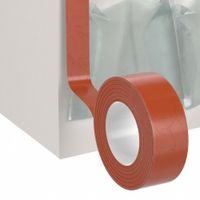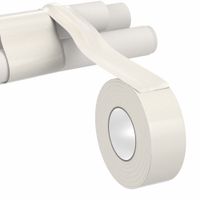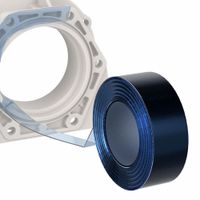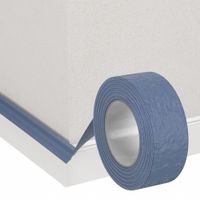Call +(254) 703 030 000 / 751 483 999 / 721 704 777
- Home
- Adhesives Sealants And Tape
- Tape
- Masking Tape Painter S Tape Dispensers
.....Read More
Frequently Asked Questions
What is masking tape made of?
Masking tape is a type of pressure-sensitive tape made of a thin and easy-to-tear paper, and an easily released pressure-sensitive adhesive. The paper is typically a crepe paper, which provides the tape with its flexibility and ease of tearing. This crepe paper is often made from a combination of wood pulp and other fibers, which gives it a slightly textured surface that helps the tape adhere to surfaces without leaving a residue.
The adhesive used in masking tape is usually a rubber-based adhesive, which is designed to stick to surfaces firmly but can be removed without leaving a sticky residue. This adhesive is formulated to provide a balance between adhesion and removability, making it ideal for temporary applications such as painting, where it is used to mask off areas that should not be painted.
Some masking tapes are designed for specific applications and may have additional components. For example, painter's masking tape may have a special coating to resist paint bleed-through, while high-temperature masking tapes used in automotive or industrial applications may have a heat-resistant adhesive and backing.
Overall, the combination of crepe paper and rubber-based adhesive makes masking tape versatile and suitable for a wide range of applications, from painting and crafting to industrial uses.
What are the uses of masking tape?
Masking tape is a versatile adhesive tape used in various applications due to its easy-to-tear nature and ability to adhere to surfaces without leaving residue. Here are some common uses:
1. **Painting**: Masking tape is widely used in painting to cover areas that should not be painted. It ensures clean lines and prevents paint from bleeding onto unwanted surfaces.
2. **Labeling**: It serves as a temporary labeling solution, allowing users to write on it and easily remove it without damaging the surface.
3. **Crafting**: In arts and crafts, masking tape is used for creating designs, holding materials in place, and as a stencil for painting or drawing.
4. **Home Improvement**: It is used to protect surfaces during repairs or renovations, such as covering fixtures or trim when painting walls.
5. **Automotive**: In auto body shops, masking tape is used to protect parts of a vehicle during painting or detailing.
6. **Photography**: Photographers use it to mark positions on floors or to secure backdrops and props.
7. **Construction**: It helps in marking measurements or holding materials temporarily during construction projects.
8. **Office Use**: Masking tape can be used to temporarily hold papers together or to post notes on walls or desks.
9. **Electronics**: It is used to temporarily hold components in place during assembly or repair.
10. **Gardening**: Gardeners use it to label plants or to temporarily hold plant stems in place.
11. **Decorating**: It is used to create patterns or designs on walls or furniture, especially when a temporary solution is needed.
12. **Packaging**: While not as strong as packing tape, it can be used for light packaging tasks.
Masking tape's versatility makes it an essential tool in various fields, providing a temporary, non-damaging solution for numerous tasks.
How does masking tape differ from other tapes?
Masking tape differs from other tapes primarily in its composition, adhesive properties, and intended use. It is made from a thin, easy-to-tear paper and a pressure-sensitive adhesive that allows for easy application and removal without leaving residue. This makes it ideal for temporary applications, such as painting, where it is used to mask off areas to prevent paint bleed.
In contrast, duct tape is made from a fabric mesh and a strong adhesive, designed for durability and waterproofing, making it suitable for heavy-duty repairs. Electrical tape, made from vinyl, is used for insulating electrical wires due to its non-conductive properties. Packing tape, typically made from polypropylene or polyester, has a strong adhesive for sealing boxes and packages securely.
Masking tape's adhesive is less aggressive than that of other tapes, allowing it to be removed cleanly from surfaces like walls, wood, and glass without damage. It is available in various widths and grades, with some designed for specific surfaces or temperature conditions. Its flexibility and ease of use make it a favorite in painting, crafting, and light bundling tasks.
Overall, masking tape's unique combination of a gentle adhesive and easy-tear paper distinguishes it from other tapes, which are designed for more permanent or specialized applications.
Can masking tape withstand high temperatures?
Masking tape is generally not designed to withstand high temperatures. It is typically made from a thin and easy-to-tear paper, with a pressure-sensitive adhesive that is not formulated for heat resistance. Standard masking tape can start to degrade, lose adhesion, or even catch fire when exposed to high temperatures, usually above 150°F (65°C).
For applications involving high temperatures, such as automotive painting or industrial processes, specialized high-temperature masking tapes are available. These tapes are often made from materials like polyester or polyimide, and their adhesives are formulated to withstand higher temperatures, sometimes up to 500°F (260°C) or more.
In summary, regular masking tape is not suitable for high-temperature applications, but there are specific high-temperature masking tapes designed for such conditions.
Is masking tape suitable for painting projects?
Masking tape is generally suitable for painting projects, but its effectiveness depends on the specific requirements of the task. It is designed to protect surfaces from paint splatters and create clean lines, making it a popular choice for both amateur and professional painters. However, there are several factors to consider:
1. **Adhesion**: Masking tape has a moderate level of adhesion, which is ideal for temporary applications. It sticks well to most surfaces but can be easily removed without leaving residue. However, it may not adhere well to rough or dusty surfaces.
2. **Surface Compatibility**: It works best on smooth surfaces like walls, glass, and metal. On textured surfaces, paint can seep under the tape, leading to uneven lines.
3. **Paint Type**: Masking tape is suitable for use with water-based paints. For oil-based paints, specialized tapes with stronger adhesives may be required.
4. **Temperature and Humidity**: Extreme temperatures and high humidity can affect the tape's adhesive properties, potentially causing it to peel off or leave residue.
5. **Duration**: Masking tape is designed for short-term use. If left on a surface for too long, especially in direct sunlight, it can become difficult to remove and may leave adhesive residue.
6. **Precision**: For projects requiring high precision, such as detailed trim work, painter's tape is often recommended over standard masking tape due to its superior edge-sealing properties.
In summary, while masking tape is suitable for many painting projects, its effectiveness depends on the surface, paint type, and environmental conditions. For best results, consider the specific needs of your project and, if necessary, opt for painter's tape for more demanding applications.
Are there dispensers available for masking tape?
Yes, dispensers are available for masking tape. These dispensers are designed to hold and dispense masking tape efficiently, making it easier to cut and apply the tape. They come in various forms, including handheld dispensers, desktop dispensers, and industrial dispensers, catering to different needs and environments. Handheld dispensers are portable and often used for smaller tasks, while desktop dispensers are suitable for office or home use, providing stability and ease of use. Industrial dispensers are designed for heavy-duty applications, often used in manufacturing or large-scale projects. These dispensers can accommodate different tape widths and are equipped with features like serrated blades for clean cutting.
How do you remove masking tape without leaving residue?
To remove masking tape without leaving residue, follow these steps:
1. **Timing**: Remove the tape as soon as possible after painting or using it for other purposes. The longer it stays, the more likely it is to leave residue.
2. **Temperature**: Warm the tape slightly using a hairdryer on a low setting. This softens the adhesive, making it easier to peel off without leaving residue.
3. **Peeling Technique**: Start at a corner or edge and peel the tape back slowly at a 45-degree angle. This reduces the chance of tearing and minimizes residue.
4. **Support the Surface**: Use your other hand to support the surface as you peel, especially if it's delicate or freshly painted.
5. **Use a Solvent**: If residue remains, apply a small amount of rubbing alcohol, vinegar, or a commercial adhesive remover to a cloth and gently rub the area. Test on a small, inconspicuous area first to ensure it doesn't damage the surface.
6. **Clean the Surface**: After removing the tape and any residue, clean the area with a mild soap and water solution to remove any solvent traces.
7. **Dry the Area**: Wipe the surface dry with a clean cloth to prevent any moisture damage.
8. **Repeat if Necessary**: If residue persists, repeat the solvent application and cleaning process.
By following these steps, you can effectively remove masking tape without leaving any sticky residue behind.





